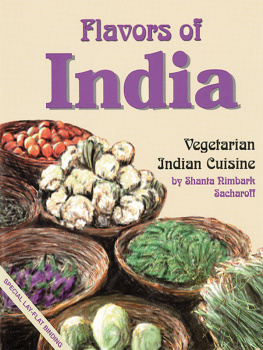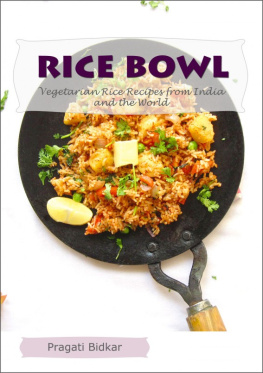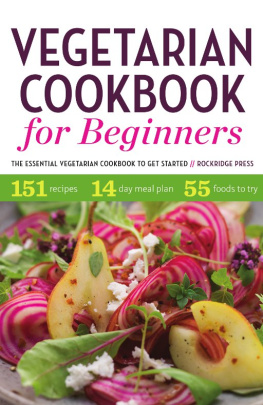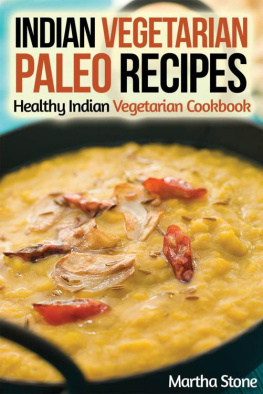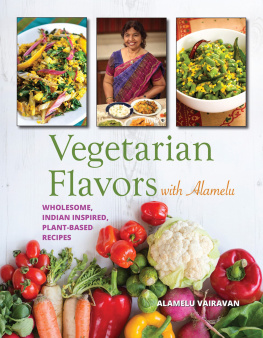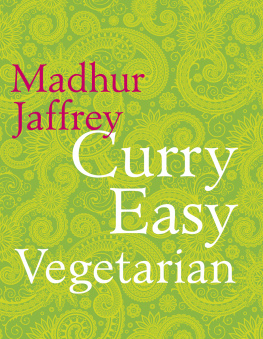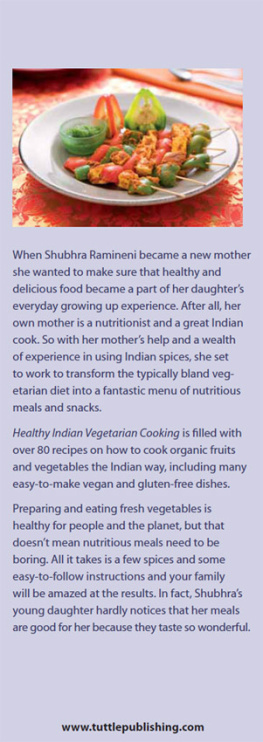All rights reserved.
Title.
TX837.S2123 1996
641.56360954--dc20 96-31917
CIP
INTRODUCTION
There are hundreds of millions of vegetarians in this world. Among those are religious Hindus, Buddhists, and Jains, as well as many other individuals who respect and honor animal life. There are also many people who cannot afford to eat meat or do not have the means to preserve it. In addition, many conscientious people avoid meat because of the many health hazards associated with it or because it is ecologically infeasible for our planet.
Historically, India has had a large vegetarian population. The Indian vegetarian diet evolved from the basic Hindu belief that all beings are sacred and that the human being is just one of them. It is not known exactly when Hindus began to restrict meat from their diet, but the vegetarian way of life in India goes beyond religious conviction.
The mostly rural economy of India depends on animals for agricultural support rather than as dietary staples. Thus, the cow has become a symbol of mother earth in Hinduism for her ability to produce milk and give birth to the bullocks that are still used to plow Indian farms today. For all these reasons, a large portion of India's population still remains vegetarian.
Indian cuisine has also been influenced by cultures from outside and has adopted many interesting traits. For instance, the British and Moguls (Muslims of Mongol, Turkish, and Persian descent) influenced Indian cookery by combining meat with various spiced sauces, which later became curries. It was fashionable among certain Westernized Indians to include meat in their diet during and after the raj era of British rule. Currently, the trend is reversing as educated Indians rediscover the virtues of their vegetarian heritage. Although Indian restaurants catering to an omnivorous clientele may offer more meat entrees than vegetarian dishes, Indian home cooking remains mostly vegetarian.
In India, where food is not always abundant, seasonal and dried foods are utilized carefully to create the daily menu. Here in the United States, the proverbial land of melting pots where a bounteous variety of food is always around, a meatless menu is rather easy to put together. Why then do many Americans find it difficult to sustain a meatless diet? A lack of satisfying taste and a concern over nutrition are the two most common reasons given by people who struggle to maintain a vegetarian diet in the West. There is another important factor which makes it difficult for vegetarians to maintain their life style. There is a noticeable lack of cultural support for vegetarians in our Western, meat-centered society. Even after widely publicized research exposing the connections between heart disease and meat consumption, many restaurants in the United States do not even have vegetarian entrees!
This book is a gift to youthe vegetarians who want to add new flavor to your daily menu, who want to be more confident about its nutritional value, and who want to find support in sustaining a vegetarian path. The book is also for those adventurous and professional chefs who simply want to expand their culinary repertoire by adding ethnic vegetarian entrees.
The first two chapters provide basic information regarding vegetarian nutrition. Some of the traditional recipes which follow have been altered by me to make them more nutritious. Some of the changes I offer will delightfully surprise you by showing you how simple, yet nutritious, Indian food can be when incorporated with local, seasonal foods.
It is easy to maintain a meatless diet using Indian vegetarian recipes in general and this book in particular for these reasons:
1) The food is colorful and appetizing.
2) Regional variations make Indian menus quite diverse.
3) The menus can be nutritionally balanced easily.
In India, my family was always attentive to the subtle flavors of food. Later, in America, I learned about the nutritional quality of food. I offer you the results! Here is a book that combines traditional Indian dishes with an eye for their nutritional value and a touch of my own imagination, which is what cooking is all about. Food made with recipes from this book are nutritious, inexpensive, and delicious!


CHAPTER ONE
VEGETARIAN NUTRITION
Nutrition is the sacred tie between the foods we eat and how our bodies utilize them; good nutrition ensures good health. In addition, nutrition can explain how people are connected socially, economically, and spiritually through the food they eat and share. A complete understanding of nutrition requires not only a knowledge of how the body uses food, but an awareness of the role society plays in shaping how people of different cultures treat the food they eat.
In this chapter and the next, you will get a brief introduction to the immensely complex subject of nutrition. It will include information on maintaining a well-balanced diet in general and a vegetarian diet in particular, with a focus on the traditional menus of India. Social factors have had an adverse effect on diet in modern societies, so a list of recommendations to remedy poor eating habits is also included.
Proper nutrition provides the body with the elements necessary for optimal growth and health, better known as nutrients. Most books on nutrition provide information on a simplified balanced diet, which divides food into four major food groupsproteins, carbohydrates, fats, and micronutrients (vitamins and minerals). Proteins (meat, dairy, beans, nuts, etc.) are usually placed on top of the nutrition chart as body-building nutrients (recommending generous servings); followed by carbohydrates (grains, starches, and cereals) as the ideal fuel foods; fats (oil, butter) as the energy store house; and vitamins and minerals (fruits and vegetables) as the regulators of all these functions. This simplistic analysis is adequate, but limited, in light of new research in the areas of food and nutrition.
Based on this research, there are recently published books on vegetarian nutrition which challenge the now outdated, but still popular, notions of the four separate food groups. The complex machinery of our bodies utilizes all of the nutrients listed in the four food groups simultaneously and interdependently. Therefore, no one food is more important than the other, although the body's need for each nutrient may vary in quantity depending on many factors, such as life-style, gender, age, climate, activity, and general state of health.
The Recommended Daily Dietary Allowances (RDAs) recommended by the Food and Nutrition Board of the National Research Council are only estimated values for the various major nutrients we need for growth and good health and represent only a generalized picture of the body's daily need for these nutrients. Specific needs for a particular group (or individual) should be taken into account. People engaging in heavy physical labor need more carbohydrates than office workers. A pregnant woman may need more protein than her husband. A cold climate may require consumption of more fats than a hot climate. Some research points out that the body can even adapt to a limited amount of nutrients if not all the nutrients are sufficiently available. Such is the case among some poor farmers in India who work all day long with a meager diet of few rotis (bread) and little bit of

